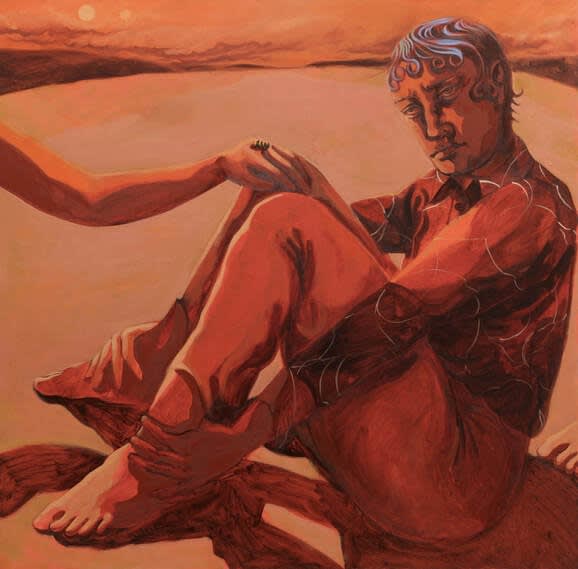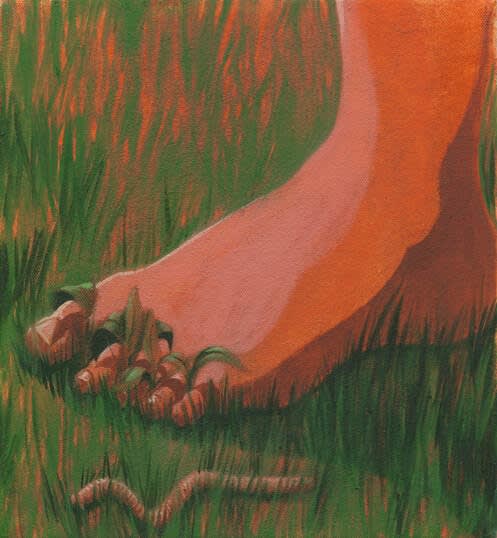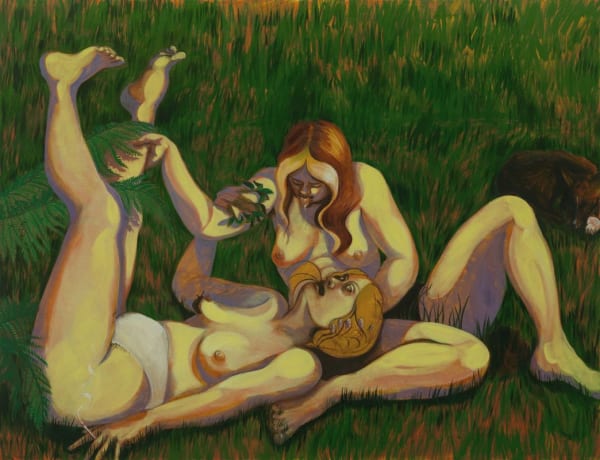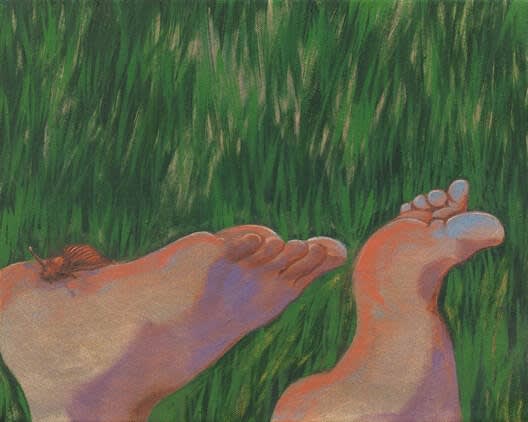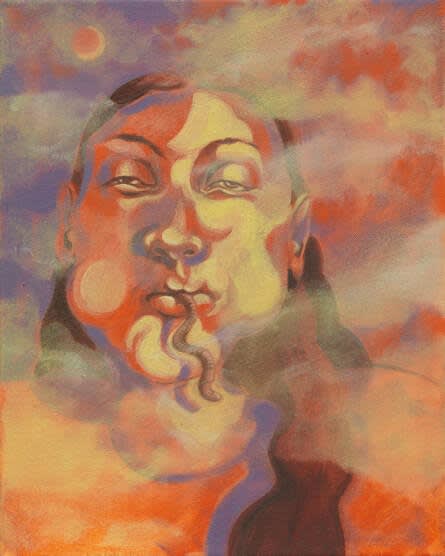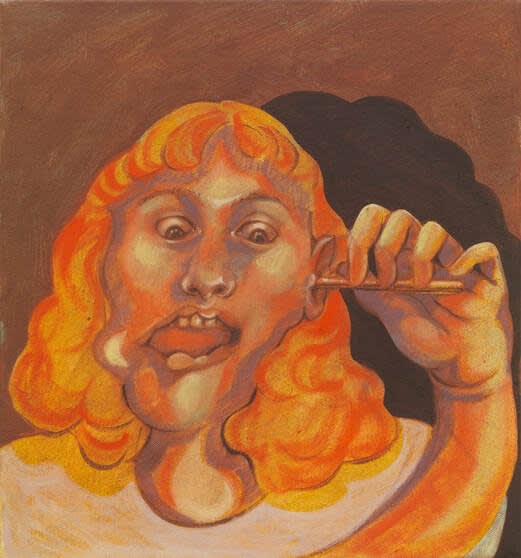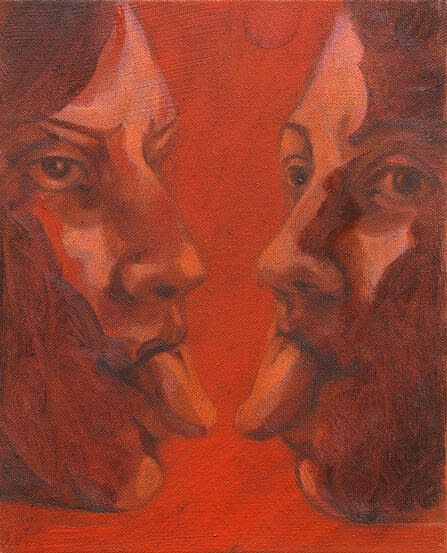NETTLE GRELLIER
@NETTLEGRELLIERARTIST
I have been a huge fan of the work of Nettle Grellier for years, so launching this interview has been a real dream!
Grellier’s work has quite literally permitted my dreams. The splendid, surreal, nature filled works have a dream like quality to each, telling stories of intimacy, relationships, awkwardness and ideas of the environment.
Her works really ignite something nostalgic in me, the grass peeping between the toes on the canvas feel as though they are tickling mine on a summers day with beating heat.
She says: “A gormless expression is so deliciously intimate to me because the subject is not aware of being seen this way. As is the image of two people entwined in an embrace verging on the uncomfortable – knowing that one person probably has pins and needles but doesn’t have the heart to pull away from the other.”
-
INTERVIEW
LET'S START BY, CUOLD YOU PLEASE Tell us a bit about you, how you became the artist we love today, and a bit about your work NETTLE?
Both of my parents are artists, so I grew up in their studios and now my own studio is my favourite place. I graduated with a BA from Brighton in 2015 and built a home in a truck and travelled mainly around Spain, exhibiting a few times in Barcelona before setting up a residency for early career artists just outside of Granada. I came back to England in 2018 and lived in Cornwall. Now I’m based in Stroud where I completed Turps Banana Correspondence Course which I am finding really useful as I am thinking now about how and when to study an MFA.
How would you describe what you do in 3 words?
No idea really.
How would you describe the themes in your work?
I would say I make paintings about intimacy, awkwardness, our relationship to nature and the climate disaster. I have a keen interest in colour combinations.
Who or what are your influences And how do they come out in your work? Who are the figures in your gorgeous works?
Artists of the top of my head who’s work I love a lot: Tamara de Lempicka, John D. Graham, Amrita Sher-Gil, Arshile Gorky, Paula Rego, Naudline Pierre, Zoe Spowage, Sara Anstis, Jessie Makinson, Somaya Critchlow..
I am drawn to figurative painters, those whose subjects are not for show but for themselves.
I’m fascinated by the awkward intimacy of human interaction. A gormless expression is so deliciously intimate to me because the subject is not aware of being seen this way. As is the image of two people entwined in an embrace verging on the uncomfortable – knowing that one person probably has pins and needles but doesn’t have the heart to pull away from the other.
I’m also currently influenced by the landscapes of the last two places I have lived; Cornwall and Southern Spain. In both I lived in towns that weren’t the picture postcard rural landscape we think of when we imagine those places, they had an honest grubbiness to them which I am very compelled by. I think a lot about empty landscapes that have been dried up and left.
When thinking of your work I think of deep, rich auburn, warm palettes, but occasionally there are these gorgeous colder hues. It’s stunning. Talk to us about colour? How do you use it?
I decided I had thing or two to learn about colour a couple of years ago so I spent some time massively restricting my colour pallet, and the reintroducing colours as combinations of two or three with the help of a book called A Dictionary of Colour Combinations by Sanzo Wada. I’m starting to get a feel now for how I want to work with colour in my paintings but I’ve got a long way to go. As I write I’m trying to paint a mostly green painting for the first time in a while, a colour I’ve always struggled with. My preference is to put a ground down in a warm, almost fluorescent orange or pink and use a complimentary colour over the top, it really vibrates and is so exciting to paint.
How does each work come to be? How do you work? What is your process for each work?
I do plenty of drawing, but never really plan an entire painting. For me the key to a successful painting is to strike a balance between preparation in the form of lots of drawings to work from and keep your eye in, and allowing space for spontaneity.
As I said I start with a nice ground, then I will have my sketchbooks out on the floor to refer to whilst I sketch in the figures using paint. Next, I will focus on light and then the landscape, finally working out the finer details like textiles and anything else.
Have you had any memorable responses to your work? And which artwork is your favourite that you have produced?
A dog I found in Spain walked into the studio and pissed all over a painting I was working on.
HAHA! A COMPLIMENT INDEED!
I couldn’t say which painting is my favourite. Usually it’s the one I have just finished, until I make something new and then I can just see where I could have improved on the ones that came before. I don’t tend to go back to paintings though, I hate over working and would rather just take what I’ve learnt and make something new.
What is your secret indulgence?
Expensive bath products even when I can’t really afford them. I lived in a truck and washed out of a bucket and then had limited showers for a few years so it’s no surprise and not really a secret.
What are your artist necessities? What could you not live without?
Lockdown has taught me that the answer is 6B pencils, a rubber and plenty of paper.
Who is your favourite historical and contemporary female artist?
Historical:
Amrita Sher-Gil 1913-1941,
Contemporary:
Jessie Makinson,
Julia Trybala
Naudline Cluvie Pierre
Somaya Critchlow
Zoe Francis Powage
Oriele Steiner
Plum Cloutman
Sara Anstis
Who should She Curates interview next?
I’d really like to know more about Gabrielle Banks’ work.
Is there anything else you want to say?
I’m writing this at a time of great anger and sorrow.
In the art world we are supposed to be a cultural window; museums, galleries and artists profit from black culture yet do not fight hard against the oppression of black people. Here in the UK we have national museums full of stolen art and cultural artefacts from black and indigenous communities worldwide as a result of our colonial past. This is not at all adequately taught about in our schools or in universities and so the individuals within our industry continue to perpetuate and benefit from the racism that it stems from. I know now that the education I received at Brighton University was not whole, there were huge chunks of historical and contemporary knowledge that were missed out on because of the lack of representation. I must also acknowledge that this is something I was not vocal about at the time of studying, and it should have been.
If our institutions and education are not honest about our colonial origins and don’t start actively providing reparations and proper representation then we can’t expect Black artists to thrive in university and gallery settings.








